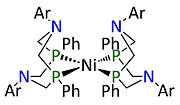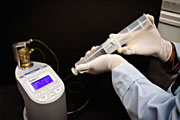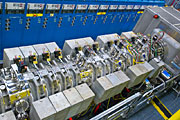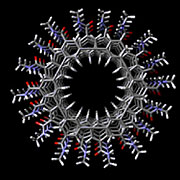- Number 368 |
- July 30, 2012
-
Ionic liquid improves speed and efficiency of hydrogen-producing catalyst
 The design of a nature-inspired material that can make energy-storing hydrogen gas has gone holistic. Usually, tweaking the design of this particular catalyst—a work in progress for cheaper, better fuel cells—results in either faster or more energy-efficient production but not both. Now, researchers at DOE’s Pacific Northwest National Laboratory have taken a holistic approach that allows the creation of hydrogen faster without a loss in efficiency.
The design of a nature-inspired material that can make energy-storing hydrogen gas has gone holistic. Usually, tweaking the design of this particular catalyst—a work in progress for cheaper, better fuel cells—results in either faster or more energy-efficient production but not both. Now, researchers at DOE’s Pacific Northwest National Laboratory have taken a holistic approach that allows the creation of hydrogen faster without a loss in efficiency.
This new approach requires the entire system—the hydrogen-producing catalyst and the liquid environment in which it works—to overcome the speed-efficiency tradeoff. The results, in the Proceedings of the National Academy of Sciences, provide insights into making better materials for energy production. -
Field-proven meter rapidly determines carbon dioxide levels in groundwater
 DOE's National Energy Technology Laboratory (NETL) and West Virginia University collaborators discovered that a standard beverage industry carbonation meter used with a modified field protocol accurately determined the amount of CO2 dissolved in natural springs and mine waters within the range of 0.2 - 35 millimole (a mole is a measurement for chemicals, thus a millimole is one thousandth of a mole) of CO2. The meter, which measures dissolved CO2 based on temperature and pressure changes determined during sample volume expansion, offers a new way to measure dissolved CO2 rapidly and reproducibly in a wide range of natural waters, which is critical when investigating possible leakage from carbon sequestration sites.
DOE's National Energy Technology Laboratory (NETL) and West Virginia University collaborators discovered that a standard beverage industry carbonation meter used with a modified field protocol accurately determined the amount of CO2 dissolved in natural springs and mine waters within the range of 0.2 - 35 millimole (a mole is a measurement for chemicals, thus a millimole is one thousandth of a mole) of CO2. The meter, which measures dissolved CO2 based on temperature and pressure changes determined during sample volume expansion, offers a new way to measure dissolved CO2 rapidly and reproducibly in a wide range of natural waters, which is critical when investigating possible leakage from carbon sequestration sites.
-
Artificial pores mimic key features of natural pores
Scientists have overcome key design hurdles to expand the potential uses of nanopores and nanotubes. The creation of smart nanotubes with selective mass transport opens up a wider range of applications for water purification, chemical separation and fighting disease.
Nanopores and their rolled up version, nanotubes, consist of atoms bonded to each other in a hexagonal pattern to create an array of nanometer-scale openings or channels. This structure creates a filter that can be sized to select which molecules and ions pass into drinking water or into a cell. The same filter technique can limit the release of chemical by-products from industrial processes. -
DataONE portal streamlines access to environmental data
Environmental researchers who investigate climate change, invasive species, infectious diseases, and other data-intensive topics can now benefit from easy access to diverse datasets through technology released by the Data Observation Network for Earth, or DataONE.
Understanding broad and complex environmental issues increasingly relies on the discovery and analysis of massive datasets. But the amount of collected data – from historical field notes to real-time satellite data – means that researchers are now faced with an onslaught of options to locate and integrate information relevant to the issue at hand.




